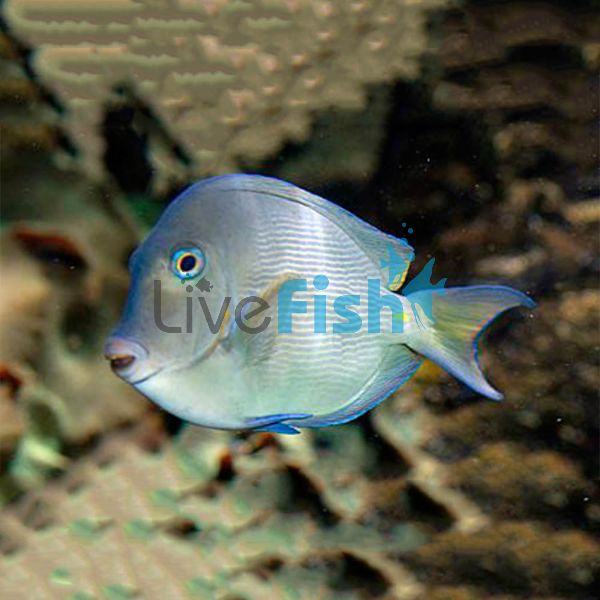Striatus Tang - Medium
The Striatus Tang is an active fish which loves swimming. It enjoys eating algae and will do a great job of keeping your tank clean.
The Striatus Tang is part of the Ctenocbaetus genus. They are distinctive because of the bristle-like teeth. These are used to sift and sort through substrate and scrape rocks. This along with the juveniles colouration gives rise to one of their other common names the Orange Stripe Bristletooth Tang. The juveniles have horizontal orange lines running down their body. Whilst the adults have an olive coloured body, which has thin wavy blue lines running down it. There are orange dots on its head around its eye.
Information about breeding habits is limited. In Tahiti they spawn around full moon. Thousands of fish congregate where they remain still for 1-3 hours then change colour to grey. Groups of 4 or 5 Tang will rise from the group and release milt and eggs.
Striatus Tang are found in Indo-Pacific waters and even as far as the Red Sea. This includes areas such as Sumatra, Indonesia, Australia, and Fiji. They usually inhabit reefs and lagoons between depths of 6-30 meters.
Tank Recommendations for Striatus Tangs
Striatus Tangs need a tank that is at least 150 gallons (568 litres) capacity.
They are suitable in a reef or fish only tank. As they are active swimmers there should be plenty of open water space. A suitable aquarium should be mature with plenty of algae growth. There should be rock and stones with algae available for them to graze on. If there isn't enough algae, feeding should be increased and supplemented with spirulina.
Rockwork should also offer plenty of caves and crevice for hiding and shelter. Especially when they are new in an aquarium.
Suitable Tank Buddies
Striatus Tangs are semi-aggressive. They are generally peaceful but can be territorial and show aggression to conspecifics. The Ctenochaetus genus has a more relaxed temperament than some other Tangs. It is better suited to a more in a more peaceful environment than with aggressive species.
Usually Compatible
It is recommended to keep one specimen per tank although they can co habit as part of a mated pair. Their most suitable tank buddies are peaceful fish. Suitable options include Blennies, Dragonets, Pseudochromis, Chromis, and reef safe Wrasse.
Sometime Compatible
Care should be taken with Foxfaces/Rabbitfish, Batfish. Other grazers should also be monitored as they may out compete it for food.
Rarely Compatible
More aggressive Tangs unsuitable as they may harass Striatus Tangs. Seahorses and Pipefish are too delicate to co-habit with Tangs.
Feeding Your Striatus Tang
Striatus Tangs are primarily herbivores, although they will eat meaty foods in a tank. A suitable diet should be algae based and include marine algae, spirulina, and seaweed such a Nori. They will also consume suitable flake food. Seaweed can be attached to rock with a veggie clip. If they are also grazing on algae, feeding should occur at least 3 times per week.
| Scientific Name | Ctenochaetus Striatus |
|---|---|
| Care Level | Moderate |
| Common Names | Striatus Tang, Striated Surgeonfish, Orange Dotted Bristletooth, Striped Bristletooth, Fine Lined Tang, Fine lined Bristletooth, Lined Bristletooth, Orange Lined Tang, Orange Striped Bristletooth Tang. |
| Diet | Herbivore |
| Fish Family | Acanthuridae |
| Lifespan (years) | 25 |
| Max. Length (cm) | 25 |
| Min. Tank Volume (l) | 568 |
| Origin | Red Sea, Indo-Pacific, Sumatra, Indonesia, Australia, and Fiji |
| Reef Safe | Yes |
| Sociability | Semi-aggressive |
| Venomous | Yes |
| Water Conditions | 22.2-25.5° C (72-78° F), dKH 8-12, pH 8.1-8.4, sg 1.020-1.025 |




